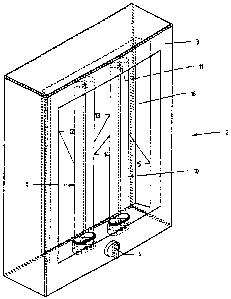Some of the information on this Web page has been provided by external sources. The Government of Canada is not responsible for the accuracy, reliability or currency of the information supplied by external sources. Users wishing to rely upon this information should consult directly with the source of the information. Content provided by external sources is not subject to official languages, privacy and accessibility requirements.
Any discrepancies in the text and image of the Claims and Abstract are due to differing posting times. Text of the Claims and Abstract are posted:
| (12) Patent Application: | (11) CA 2352763 |
|---|---|
| (54) English Title: | PROCESS AND APPARATUS FOR THE COSMETIC TREATMENT OF ACNE VULGARIS |
| (54) French Title: | METHODE DE TRAITEMENT COSMETIQUE DE L'ACNE COMMUNE ET APPAREIL CORRESPONDANT |
| Status: | Deemed Abandoned and Beyond the Period of Reinstatement - Pending Response to Notice of Disregarded Communication |
| (51) International Patent Classification (IPC): |
|
|---|---|
| (72) Inventors : |
|
| (73) Owners : |
|
| (71) Applicants : |
|
| (74) Agent: | SMART & BIGGAR LP |
| (74) Associate agent: | |
| (45) Issued: | |
| (86) PCT Filing Date: | 1998-12-04 |
| (87) Open to Public Inspection: | 2000-06-08 |
| Examination requested: | 2003-11-26 |
| Availability of licence: | N/A |
| Dedicated to the Public: | N/A |
| (25) Language of filing: | English |
| Patent Cooperation Treaty (PCT): | Yes |
|---|---|
| (86) PCT Filing Number: | PCT/EP1998/007884 |
| (87) International Publication Number: | WO 2000032272 |
| (85) National Entry: | 2001-05-30 |
| (30) Application Priority Data: | ||||||
|---|---|---|---|---|---|---|
|
In a process for the cosmetic treatment of acne vulgans by irradiation of the
affected skin areas with light two emission spectra are used, one in the blue
region (A) from 400 to 450 nm, the other in the red region (B) from 580 to 659
nm. The resulting spectrum is adapted to the action spectrum for the
inactivation of the propionibacterium acne. It has a biostimulating effect on
the skin cells.
On soumet, dans le cadre de ce traitement cosmétique de l'acné commune, les régions atteintes de la peau au rayonnement de deux spectres optiques, l'un appartenant à la plage de la région du bleu (A), comprise entre 400 et 450 nm et l'autre appartenant à la plage du rouge (B), comprise entre 580 et 659 nm. Le spectre résultant, qui est adapté au spectre d'action inactivant l'acné propionibactérienne, possède une action biostimulante sur les cellules cutanées.
Note: Claims are shown in the official language in which they were submitted.
Note: Descriptions are shown in the official language in which they were submitted.

2024-08-01:As part of the Next Generation Patents (NGP) transition, the Canadian Patents Database (CPD) now contains a more detailed Event History, which replicates the Event Log of our new back-office solution.
Please note that "Inactive:" events refers to events no longer in use in our new back-office solution.
For a clearer understanding of the status of the application/patent presented on this page, the site Disclaimer , as well as the definitions for Patent , Event History , Maintenance Fee and Payment History should be consulted.
| Description | Date |
|---|---|
| Application Not Reinstated by Deadline | 2007-12-04 |
| Time Limit for Reversal Expired | 2007-12-04 |
| Inactive: Abandoned - No reply to s.30(2) Rules requisition | 2007-02-16 |
| Deemed Abandoned - Failure to Respond to Maintenance Fee Notice | 2006-12-04 |
| Inactive: S.30(2) Rules - Examiner requisition | 2006-08-16 |
| Letter Sent | 2003-12-05 |
| Request for Examination Received | 2003-11-26 |
| All Requirements for Examination Determined Compliant | 2003-11-26 |
| Request for Examination Requirements Determined Compliant | 2003-11-26 |
| Letter Sent | 2002-01-08 |
| Inactive: Single transfer | 2001-11-13 |
| Inactive: Cover page published | 2001-09-27 |
| Inactive: First IPC assigned | 2001-08-29 |
| Inactive: Courtesy letter - Evidence | 2001-08-14 |
| Inactive: Notice - National entry - No RFE | 2001-08-06 |
| Application Received - PCT | 2001-08-03 |
| Application Published (Open to Public Inspection) | 2000-06-08 |
| Abandonment Date | Reason | Reinstatement Date |
|---|---|---|
| 2006-12-04 |
The last payment was received on 2005-11-29
Note : If the full payment has not been received on or before the date indicated, a further fee may be required which may be one of the following
Please refer to the CIPO Patent Fees web page to see all current fee amounts.
| Fee Type | Anniversary Year | Due Date | Paid Date |
|---|---|---|---|
| MF (application, 3rd anniv.) - standard | 03 | 2001-12-04 | 2001-05-30 |
| Basic national fee - standard | 2001-05-30 | ||
| MF (application, 2nd anniv.) - standard | 02 | 2000-12-04 | 2001-05-30 |
| Registration of a document | 2001-11-13 | ||
| MF (application, 4th anniv.) - standard | 04 | 2002-12-04 | 2002-12-02 |
| Request for examination - standard | 2003-11-26 | ||
| MF (application, 5th anniv.) - standard | 05 | 2003-12-04 | 2003-11-26 |
| MF (application, 6th anniv.) - standard | 06 | 2004-12-06 | 2004-11-25 |
| MF (application, 7th anniv.) - standard | 07 | 2005-12-05 | 2005-11-29 |
Note: Records showing the ownership history in alphabetical order.
| Current Owners on Record |
|---|
| SLI LICHTSYSTEME GMBH |
| Past Owners on Record |
|---|
| WOLFGANG KOHLER |